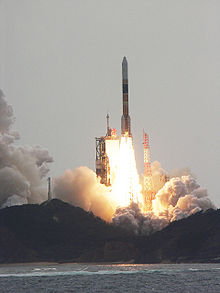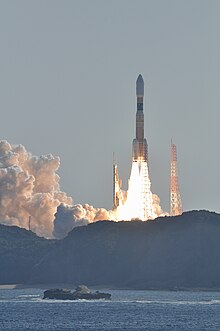H-II
The H-II is a Japanese launcher . Despite the similarity to the name of the HI , it was completely redeveloped.
The three to four-digit carrier designation is derived from the rockets and the boosters used. The first digit means the rocket (1 = H-II, 2 = H-IIA, 3 = H-IIB) and the following digits mean the number of LRBs (Liquid-fuel rocket boosters), SRBs (Solid- fuel rocket boosters, solid rocket boosters) and SSBs (solid sub boosters).
H-II
The development of the H-II rocket began in 1986. It followed a similar concept to the Ariane 5 : two solid fuel boosters provide the necessary take-off thrust, and a single engine is responsible for the main acceleration. The engine of the H-II is an LE-7 operated with liquid oxygen and hydrogen ( LOX / LH2 = Liquid Oxygen / Liquid Hydrogen ) and according to the main flow process with a hydraulically swiveling nozzle. These engines were a big step forward for Japanese space travel, but they also posed some problems with their costly development ($ 800 million of the $ 2.3 billion total cost of the rocket). The engine test began in 1988, with two tests failing in 1989, which delayed the first flight by two years. Together with a modified second stage, taken over from HI, with the modern and re-ignitable LE-5A engine with a hydraulically swiveling nozzle, the H-II is able to transport up to 10 t payload into the Low Earth Orbit (LEO) . They were available with two different payload fairings, 4.1 m and 5 m in diameter. The latter was only used once for the third launch of the rocket, during which the rocket was additionally supported by two laterally mounted Nissan Castor-IV AXL solid fuel boosters (licensed by Thiokol) with a length of 9.5 m, each 10 t take-off weight and 600 kN thrust .
Although the H-II was technically up to date, the high complexity of the rocket and the associated high launch costs and low reliability prevented commercial success, so production was discontinued and the H-IIA was developed. Today there is still a copy in front of the visitors' center at the launch site.
- First flight: February 3, 1994
- Starts: 7, including 1 false start and 1 partial success
- Reliability: 71.4%
- Start-up costs: US $ 190 million (1994)
H-IIA
In order to make the H-II design commercially competitive, the start-up costs had to be reduced. To achieve this, the concept was made more flexible. The construction of the previously used HTPB- operated booster (now shorter, but made up of one piece instead of segments), the step transition (now made of carbon fiber reinforced plastic ) and the tank construction have been simplified. By using different solid fuel boosters (SRB or SSB) and originally planned but later discontinued boosters with liquid fuels (LRB), it is possible to cover a large payload range and keep costs low. As an LRB, one or even two first stages were planned similar to the Delta IV Heavy . There were also changes to the engines, so the turbo pumps of the LE-7A first-stage engine, which were mounted on the side of the H-II, were now installed above it, which lengthened the engine accordingly. The modified second stage engine LE-5B provides 13% more thrust. Instead of just two, five different payload fairings are now available with lengths between 12 m and 16 m and diameters between 4.07 m and 5.10 m. The rocket has been available on the commercial market since fiscal 2007. So far, the military use of the H-IIA has remained largely unknown. Four of its launches served to deploy reconnaissance satellites to monitor North Korea.
- First flight: 2001
- Starts: 30, including 1 false start
- Reliability: 96.66%
- Startup costs: 9.3 to 12 billion yen / 85 to 110 million US $ (depending on the booster configuration and length of stay on the launch pad) (exchange rates as of November 26, 2007)
Possible booster combinations and corresponding carrier names:
- H-IIA-202 (in operation): 2 × SRB-A
- H-IIA-204 (in operation): 4 × SRB-A
- H-IIA-2022 (in operation): 2 × SRB-A + 2 × SSB
- H-IIA-2024 (in operation): 2 × SRB-A + 4 × SSB
H-IIB
The H-IIB (older name H-IIA-304) is a further development of the H-IIA rocket, which is designed for heavier payloads, such as the HTV (16.5 t). The first stage of the rocket has a larger diameter (5.2 m instead of 4 m) and has two LE-7A engines as well as four side, solid-propelled boosters (length 56 m, mass 551 t). The GTO payload capacity should be around 8 tons. The development of the rocket began in 2004 with a budget of around 20 billion yen (the equivalent of around 150 million euros).
On April 2 and April 22, 2009, test ignitions took place at the launch site in Tanegashima , both of which were successful.
This was followed on July 11, 2009 by an intensive test with subsequent launch simulation (Ground Vehicle Test) in which the almost complete H-IIB missile was subjected to a simulated countdown on the launch pad. Only the payload adapter, the payload and the payload fairing were missing in this test.
The first launch on September 10th, 2009 was called TF-1 (TF = Test Flight). The space transporter H-2 Transfer Vehicle (HTV) was successfully brought into space .
Technical specifications
The boosters run on solid fuel. Liquid oxygen (LOX) and liquid hydrogen (LH2) serve as rocket fuel in the first and second stages.
| Model | H-II | H-IIA | H-IIB | |
|---|---|---|---|---|
| stages | 2 + booster | |||
| height | 49 m | 53-57 m | 56 m | |
| diameter | 4.0 m | 4.0 m | 5.2 m | |
| Takeoff mass | 260 t | 285 - 347 t | 531 t | |
| Start thrust | 3962 kN | up to 4913 kN | 8372 kN | |
| payload | 10 t LEO 4 t GTO |
10–15 t LEO 4–6 t GTO |
19 t LEO 8 t GTO |
|
| booster | ||||
| Type | H-II-0 | SRB-A | SSB | SRB-A |
| number | 2 | 2-4 | 0-4 | 4th |
| height | 23.36 m | 15.2 m | 14.9 m | 15.2 m |
| diameter | 1.81 m | 2.5 m | 1.0 m | 2.5 m |
| Empty mass | 11.25 t | 10.4 t | 2.5 t | 10.55 t |
| Takeoff mass | 70.4 t | 76.4 t | 15.5 t | 76.5 t |
| Engine | H-II-0 with 1,540 kN thrust | SRB-A with 2,245 kN thrust | Castor 4XL with 745 kN thrust | SRB-A with 4 × 2,305 kN thrust |
| Burn time | 94 s | 120 s | 60 s | 114 s |
| 1st stage | ||||
| Type | H-II-1 | H-IIA-1 | ||
| height | 28 m | 37.2 m | 38.2 m | |
| diameter | 4.0 m | 4.0 m | 5.2 m | |
| Empty mass | 11.9 t | 13.6 t | 24.2 t | |
| Takeoff mass | 98.1 t | 113.6 t | 202 t | |
| Engine | LE-7 with 844/1080 kN thrust 1) | LE-7A with 815 / 1096.5 kN thrust | 2 × LE-7A, a total of 2.196 kN thrust | |
| Burn time | 346 s | 397 s | 352 s | |
| 2nd stage | ||||
| Type | LE-5A | LE-5B | LE-5B-2 | |
| height | 10.7 m | 9.2 m | 11 m | |
| diameter | 4.0 m | 4.0 m | 4.0 m | |
| Empty mass | 2.7 t | 3.0 t | 3.4 t | |
| Takeoff mass | 19.7 t | 19.6 t | 20 t | |
| Engine | LE-5A with 121.6 kN thrust | LE-5B with 137.16 kN thrust | LE-5B-2 with 137.2 kN thrust | |
| Burn time | 609 s | 534 s | 499 s | |
1) Floor / vacuum thrust
Start list
See list of H-II rocket launches
Web links
- H-IIA website of JAXA (English)
- H-II in the Encyclopedia Astronautica (English)
- H-2 family , H-2A , H-2B Gunter's Space Page (English)
- Bernd Leitenberger: Japanese missiles
Individual evidence
- ^ Flight International, November 28, 1990 FlightGlobal
- ↑ Eugen Reichl: The rocket type book . 1st edition. 2007, ISBN 978-3-613-02788-6
- ^ Scott Ritter: The West's Hysterical Reaction To North Korea .
- ^ Result of the First Captive Firing Test for the First Stage Flight Model Tank of the H-IIB Launch Vehicle. JAXA, April 2, 2009, accessed September 11, 2009 .
- ^ Result of the Second Captive Firing Test for the First Stage Flight Model Tank of the H-IIB Launch Vehicle. JAXA, April 22, 2009, accessed September 11, 2009 .
- ↑ Results of the H-IIB Launch Vehicle Ground Test Vehicle (GTV) Test. JAXA, July 11, 2009, accessed September 11, 2009 .
- ↑ Launch Result of HTV Demonstration Flight aboard H-IIB Launch Vehicle Test Flight (H-IIB TF1). JAXA, September 11, 2009, accessed September 11, 2009 .





